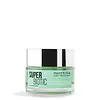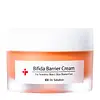What's inside
What's inside
 Key Ingredients
Key Ingredients

 Benefits
Benefits

 Concerns
Concerns

 Ingredients Side-by-side
Ingredients Side-by-side

Water
Skin ConditioningGlycerin
HumectantCoco-Caprylate
EmollientSorbitan Stearate
EmulsifyingPropanediol
SolventSaccharomyces/Xylinum/Black Tea Ferment
Skin ConditioningArgania Spinosa Kernel Oil
EmollientPrunus Amygdalus Dulcis Oil
Skin ConditioningCetyl Alcohol
EmollientPrunus Armeniaca Kernel Oil
MaskingButyrospermum Parkii Butter
Skin ConditioningOenothera Biennis Oil
EmollientSqualane
EmollientDecyl Oleate
EmollientPanthenol
Skin ConditioningAlpha-Glucan Oligosaccharide
CleansingChondrus Crispus Extract
Skin ConditioningSodium Polyglutamate
HumectantHippophae Rhamnoides Fruit Extract
Skin ConditioningAnnona Cherimola Fruit Extract
Skin ConditioningAlbatrellus Confluens Extract
HumectantPhospholipids
Skin ConditioningChlorella Vulgaris Extract
Skin ConditioningUndaria Pinnatifida Extract
Skin ConditioningSphingolipids
EmollientRosa Centifolia Flower Extract
AstringentRosa Damascena Flower Oil
MaskingRosa Damascena Flower Water
MaskingRosmarinus Officinalis Leaf Extract
AntimicrobialPantolactone
HumectantAscorbyl Palmitate
AntioxidantLecithin
EmollientXanthan Gum
EmulsifyingTocopherol
AntioxidantHelianthus Annuus Seed Oil
EmollientSodium Hydroxide
BufferingSodium Citrate
BufferingBiosaccharide Gum-1
HumectantCitric Acid
BufferingPhenylpropanol
MaskingHydrogenated Palm Glycerides Citrate
EmollientPentylene Glycol
Skin ConditioningCarbomer
Emulsion StabilisingPhenethyl Alcohol
MaskingPhenoxyethanol
PreservativeDisodium EDTA
Ethylhexylglycerin
Skin ConditioningPotassium Sorbate
PreservativePotassium Benzoate
PreservativeSodium Benzoate
MaskingSodium Dehydroacetate
PreservativeCI 42090
Cosmetic ColorantWater, Glycerin, Coco-Caprylate, Sorbitan Stearate, Propanediol, Saccharomyces/Xylinum/Black Tea Ferment, Argania Spinosa Kernel Oil, Prunus Amygdalus Dulcis Oil, Cetyl Alcohol, Prunus Armeniaca Kernel Oil, Butyrospermum Parkii Butter, Oenothera Biennis Oil, Squalane, Decyl Oleate, Panthenol, Alpha-Glucan Oligosaccharide, Chondrus Crispus Extract, Sodium Polyglutamate, Hippophae Rhamnoides Fruit Extract, Annona Cherimola Fruit Extract, Albatrellus Confluens Extract, Phospholipids, Chlorella Vulgaris Extract, Undaria Pinnatifida Extract, Sphingolipids, Rosa Centifolia Flower Extract, Rosa Damascena Flower Oil, Rosa Damascena Flower Water, Rosmarinus Officinalis Leaf Extract, Pantolactone, Ascorbyl Palmitate, Lecithin, Xanthan Gum, Tocopherol, Helianthus Annuus Seed Oil, Sodium Hydroxide, Sodium Citrate, Biosaccharide Gum-1, Citric Acid, Phenylpropanol, Hydrogenated Palm Glycerides Citrate, Pentylene Glycol, Carbomer, Phenethyl Alcohol, Phenoxyethanol, Disodium EDTA, Ethylhexylglycerin, Potassium Sorbate, Potassium Benzoate, Sodium Benzoate, Sodium Dehydroacetate, CI 42090
Bifida Ferment Extract 65%
HumectantGlycerin
HumectantNiacinamide
SmoothingDipropylene Glycol
Humectant1,2-Hexanediol
Skin ConditioningPolyglyceryl-3 Methylglucose Distearate
EmulsifyingCaprylic/Capric Triglyceride
MaskingSorbitan Olivate
EmulsifyingVinyldimethicone
Cyclohexasiloxane
EmollientStearyl Olivate
EmollientButylene Glycol Dicaprylate/Dicaprate
EmollientPropanediol
SolventMacadamia Ternifolia Seed Oil
EmollientSodium Acrylates Copolymer
Glyceryl Glucoside
HumectantButyrospermum Parkii Butter
Skin ConditioningC14-22 Alcohols
Emulsion StabilisingWater
Skin ConditioningLecithin
EmollientC12-20 Alkyl Glucoside
EmulsifyingSqualane
EmollientDimethicone/Vinyl Dimethicone Crosspolymer
Skin ConditioningButylene Glycol
HumectantHouttuynia Cordata Extract
Skin ConditioningSodium Acrylate/Sodium Acryloyldimethyl Taurate Copolymer
Emulsion StabilisingPolyisobutene
Ethylhexylglycerin
Skin ConditioningAdenosine
Skin ConditioningCaprylyl/Capryl Glucoside
CleansingSorbitan Oleate
EmulsifyingLactococcus Ferment Lysate
Skin ConditioningLactobacillus Ferment Lysate
Skin ConditioningLactobacillus/Soybean Ferment Extract
Skin ConditioningLactobacillus
Skin ConditioningYeast
Skin ConditioningLactobacillus/Pear Juice Ferment Filtrate
Skin ConditioningHydrogenated Lecithin
EmulsifyingGlucose
HumectantSoy Isoflavones
Skin ConditioningCeramide NP
Skin ConditioningCopper Tripeptide-1
Skin ConditioningAlanine
MaskingAcetyl Hexapeptide-8
HumectantBifida Ferment Extract 65%, Glycerin, Niacinamide, Dipropylene Glycol, 1,2-Hexanediol, Polyglyceryl-3 Methylglucose Distearate, Caprylic/Capric Triglyceride, Sorbitan Olivate, Vinyldimethicone, Cyclohexasiloxane, Stearyl Olivate, Butylene Glycol Dicaprylate/Dicaprate, Propanediol, Macadamia Ternifolia Seed Oil, Sodium Acrylates Copolymer, Glyceryl Glucoside, Butyrospermum Parkii Butter, C14-22 Alcohols, Water, Lecithin, C12-20 Alkyl Glucoside, Squalane, Dimethicone/Vinyl Dimethicone Crosspolymer, Butylene Glycol, Houttuynia Cordata Extract, Sodium Acrylate/Sodium Acryloyldimethyl Taurate Copolymer, Polyisobutene, Ethylhexylglycerin, Adenosine, Caprylyl/Capryl Glucoside, Sorbitan Oleate, Lactococcus Ferment Lysate, Lactobacillus Ferment Lysate, Lactobacillus/Soybean Ferment Extract, Lactobacillus, Yeast, Lactobacillus/Pear Juice Ferment Filtrate, Hydrogenated Lecithin, Glucose, Soy Isoflavones, Ceramide NP, Copper Tripeptide-1, Alanine, Acetyl Hexapeptide-8
Ingredients Explained
These ingredients are found in both products.
Ingredients higher up in an ingredient list are typically present in a larger amount.
This ingredient is also known as shea butter. It is an effective skin hydrator and emollient.
Emollients help soothe and soften your skin. It does this by creating a protective film on your skin. This barrier helps trap moisture and keeps your skin hydrated. Emollients may be effective at treating dry or itchy skin.
Shea butter is rich in antioxidants. Antioxidants help fight free-radicals, or molecules that may harm the body. It is also full of fatty acids including stearic acid and linoleic acid. These acids help replenish the skin and keep skin moisturized.
While Shea Butter has an SPF rating of about 3-4, it is not a sunscreen replacement.
Shea butter may not be fungal acne safe. We recommend speaking with a professional if you have any concerns.
Learn more about Butyrospermum Parkii ButterEthylhexylglycerin (we can't pronounce this either) is commonly used as a preservative and skin softener. It is derived from glyceryl.
You might see Ethylhexylglycerin often paired with other preservatives such as phenoxyethanol. Ethylhexylglycerin has been found to increase the effectiveness of these other preservatives.
Glycerin is already naturally found in your skin. It helps moisturize and protect your skin.
A study from 2016 found glycerin to be more effective as a humectant than AHAs and hyaluronic acid.
As a humectant, it helps the skin stay hydrated by pulling moisture to your skin. The low molecular weight of glycerin allows it to pull moisture into the deeper layers of your skin.
Hydrated skin improves your skin barrier; Your skin barrier helps protect against irritants and bacteria.
Glycerin has also been found to have antimicrobial and antiviral properties. Due to these properties, glycerin is often used in wound and burn treatments.
In cosmetics, glycerin is usually derived from plants such as soybean or palm. However, it can also be sourced from animals, such as tallow or animal fat.
This ingredient is organic, colorless, odorless, and non-toxic.
Glycerin is the name for this ingredient in American English. British English uses Glycerol/Glycerine.
Learn more about GlycerinLecithin is a term for a group of substances found in the cell membranes of plants, animals, and humans. They are made up of mixture of phospholipids.
This ingredient has emollient and emulsifying properties.
As an emollient, lecithen helps soften the skin and creates a barrier to keep moisture in.
As an emulsifier, it also helps prevent water and oil ingredients from separating. Lecithin can also help ingredients be better absorbed by the skin.
This is because the phospholipids in lecithin produce liposomes. Liposomes help other ingredients get through the skin barrier.
Depending on the source of this ingredient, lecithin may not be fungal acne safe. This is because some sources of lecithin come from soybean oil, which may feed the malassezia yeast that feeds fungal acne.
We recommend reaching out to the brand you are purchasing from to inquire about the source of their lecithin.
Some other names for this ingredient include soy lecithin and deoiled soy lecithin.
Learn more about LecithinPropanediol is an all-star ingredient. It softens, hydrates, and smooths the skin.
It’s often used to:
Propanediol is not likely to cause sensitivity and considered safe to use. It is derived from corn or petroleum with a clear color and no scent.
Learn more about PropanediolSqualane is an emollient that helps the skin hold onto moisture. It's an oily liquid that occurs naturally in certain types of fish and plant oils.
Because squalane boosts hydration in the skin, it also comes with plenty of benefits: it is an antioxidant and can help fight free radicals and skin damage. Squalane is also found to have a detoxifying effect when applied.
Squalane comes from squalene, which occurs naturally within the sebum of our skin. It is one of the oils our skin produces to keep itself hydrated. Squalane is the hydrogenated version of squalene and has a longer shelf life.
Research shows that squalane is non-irritating (even at 100% concentration).
In general, it's a fantastic ingredient. It does a great job at hydrating the skin, and it's suitable for those with sensitive skin.
The source of squalane may impact malassezia / fungal acne. This is because olive oil derived squalane can contain impurities such as fatty acids and plant waxes. Sugarcane derived squalane is recommended for anyone with malassezia concerns.
Is squalane vegan?
This depends on the source. Squalane can be derived from both plants and animals. Most squalane used in skincare comes from plants.
Please note: the source of squalane is only known if disclosed by the brand. We recommend reaching out to the brand if you have any questions about their squalane.
Read more about squalene with an "e".
Is squalane an oil?
Squalane is often called an oil, but it’s technically not; it’s a hydrocarbon, meaning it’s only made of carbon and hydrogen, unlike true oils which are triglycerides made of fatty acids and glycerol.
The term “oil-free” isn’t regulated, so companies can define it however they want. Some exclude all oils, while others just avoid mineral oil or comedogenic oils.
While some people avoid oils thinking they cause breakouts, the right kind of oil (or oil-like ingredient like squalane) can actually help balance and hydrate your skin. It’s worth testing out simple oils or squalane to see what works best for your skin.
Learn more about SqualaneWater. It's the most common cosmetic ingredient of all. You'll usually see it at the top of ingredient lists, meaning that it makes up the largest part of the product.
So why is it so popular? Water most often acts as a solvent - this means that it helps dissolve other ingredients into the formulation.
You'll also recognize water as that liquid we all need to stay alive. If you see this, drink a glass of water. Stay hydrated!
Learn more about Water